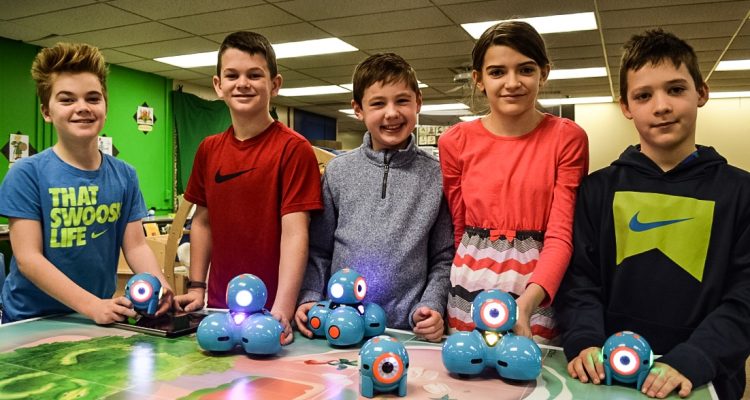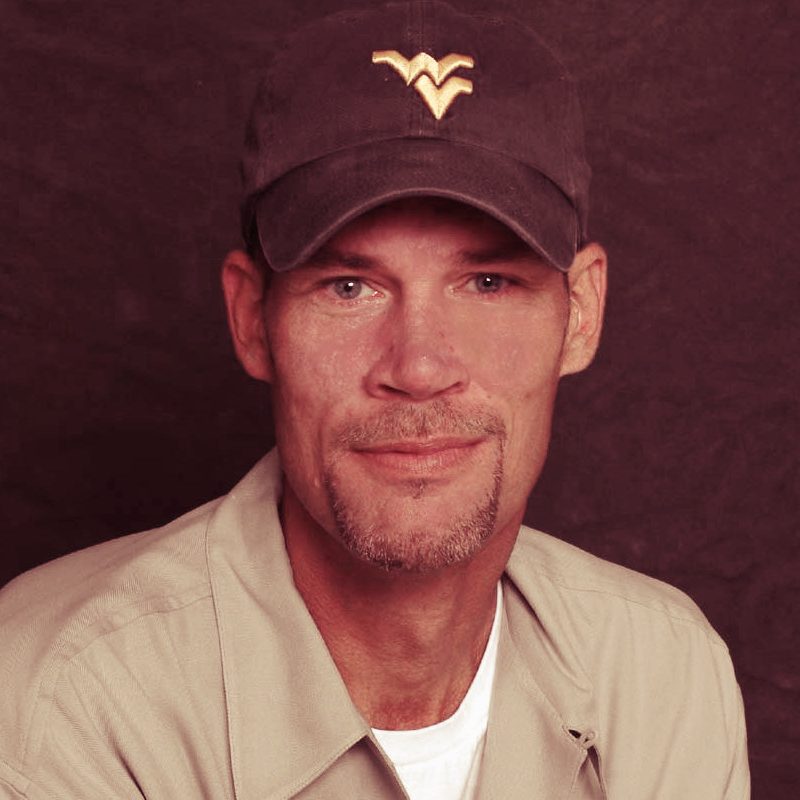Pictured above Left to Right: Campbell Koegler, Alex Taylor, Grant Kenamond, Kathryn Prather, Max Hill
Four of these five fifth graders prefer C3PO over R2D2, and they know more than most do about robots.
Only Max Hill, a member of the after-school Robotics Club at Woodsdale Elementary School, defended the small, wheel-bound droid in the legendary “Star Wars” movie series.
“Yeah, but if he has to go up somewhere, he has jet packs,” he said. “C3PO knows a lot of languages, but he doesn’t have jet packs.”
Since September, Hill has joined teammates Grant Kenamond, Alex Taylor, Kathryn Prather, and Campbell Koegler following their normal class schedules to further their studies in robotics with veteran teacher Sandra Wiseman. The team of five have been competing in the Wonder League Robotics Competition, a worldwide event that welcomed 5,000 teams of children between the ages of 9 to 12 years old.
Over the past four months the teams have competed in four of the five challenges, and thus far the Woodsdale team is one of 30 finalists – of that international group of more than five thousand – moving forward to the fifth and final coding contest and is the only group from the state of West Virginia still competing.
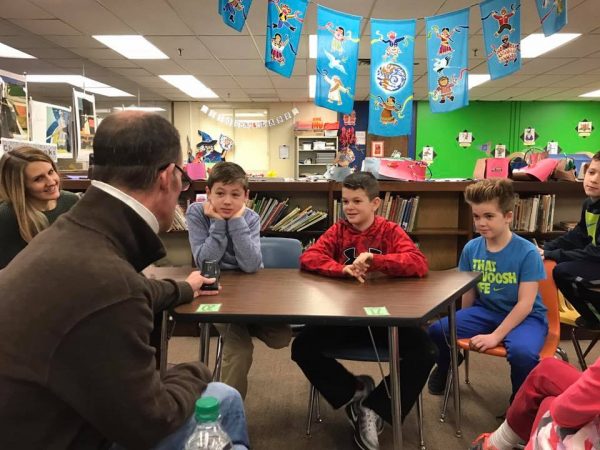
“The kids try to teach me how to code all of the time, but I’ve decided to leave that up to them and Mrs. Wiseman,” said Woodsdale Principal Ashlea Minch. “This is really a cool thing for them, and we are all super proud of them and what they have been able to accomplish. It wouldn’t be possible if not for Mrs. Wiseman because she has applied for numerous grants, and one of them was for $20,000 for the robots and the other equipment.
“She is one of the reasons why we are way ahead of the game here at Woodsdale with the STEAM and STEM education that is coming out, and that wouldn’t be possible without her,” she continued. “And the kids are having a blast doing it, and it’s my hope that it spreads to other schools in Ohio County. It’s no longer just about using a computer, but it’s about learning what powers the technology.”
Once three separate teams from Woodsdale Elementary were entered in the global event, Wiseman, who has been teaching in Ohio County Schools for 28 years, was confident the students would learn, but she did not expect much from the competition’s standings.
“When the results first came out, I decided to look to see if any local teams did well, and I did see that one team from the state of West Virginia qualified to continue onto the next challenge,” Wiseman said. “That’s when I realized it was us.
“At the beginning, we had three different robotics teams, but it was this team here that recorded the perfect score,” she said. “I was amazed, and I am very proud of the work they have done.”
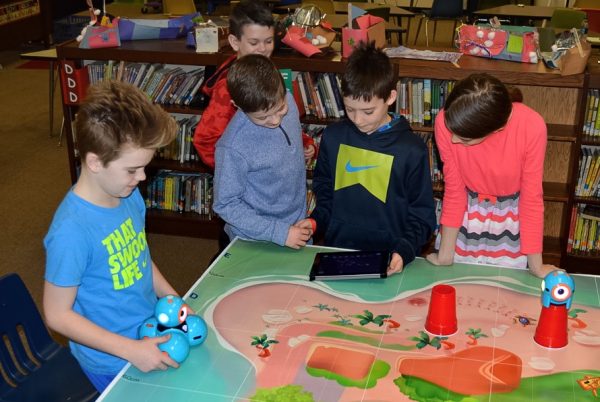
Computer coding is the practice of applying command syntax rules to technology and allows the creating of computer software for programs, smartphone and desktop applications, and for websites, as well. What these fifth graders have accomplished during the competition is composing coding solutions for technology challenges using small robots named “Dash” and “Dot.”
“It’s been a lot of fun to compete in this competition because with each one of the challenges there are a lot different answers that could apply,” Kenamond explained. “That’s when you have to work with your team members to figure out which answer is the right one for that competition.
“And that’s what we have been able to do by working with each other,” he continued. “I know we all have gone home and thought a lot about it, too, because we want to win this final challenge so we are the overall winner of the contest.”
“During the competition,” added Prather, “we get different challenges that we have completed, and one of them was that we had to code our robots to circle cups on the table. We’ve also had to build an attachment for the robot so it was able to knock ping pong balls off of a cup.”
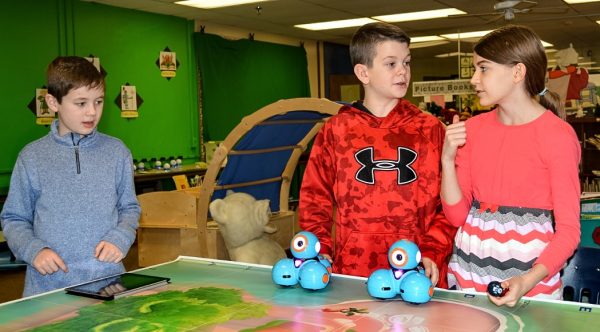
When the results revealed that Team Tiger was included in the competition’s top 1 percent, Hill’s father needed to calm his mother’s excitement. “When we were one of the top 30 teams, my mom really flipped out because she was so happy for us, and my dad was really happy, too, even though he had to settle my mom down,” he said with a smile. “They are really looking forward to seeing the results from the final competition because they believe we can do it.”
The deadline for the final challenge is Feb. 24, and with their entry they must include videoed proof of the robots performing the assigned task as well as a scientific journal explaining the group’s path to perfection.
So what, pray tell, must these fifth graders make Dot and Dash do this time?
“The final challenge involves the robot being able to drop ping pong balls into the cups,” Prather explained. “That’s a lot more difficult than making our robot knock the balls off the top of the cup.
“But we’ll be ready for it. It’s going to take a new attachment for the robot, but we’ve figured that out already,” she said. “The coding is completely different this time, too, but we’ve worked on it a lot already, and we’ve figured out most of that, too.”
Teamwork, Koegler said, has continued to be this team’s most valuable asset.
“We have all tried different things while we have worked on it, and then we came to a compromise,” he said. “It’s difficult because of the angles and the motions we have to code for the robot, but we worked together, and we’ve figured it out.”
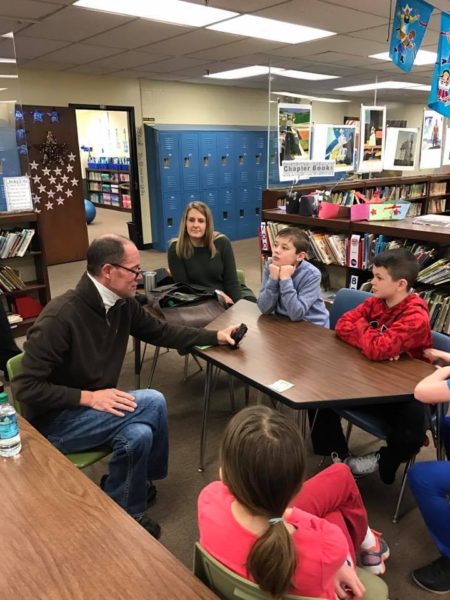
But secrecy, Kenamond insisted, must be maintained until after the deadline, and that is why no photos of the retrofitted robots have been published.
“I don’t want to reveal too much, but we did use Legos for the final challenge,” he said. “I don’t want to explain it all because we don’t want the other teams to figure out what we’ve done to be successful with the challenge.
“We don’t let a lot of people see what we have built, and there are definitely no photos of it because you never know who sees what when it comes to the Internet,” Kenamond continued. “But we’re ready for it and we’re practicing with it a lot now so we can be sure all of the coding is perfect.”
Once again Wiseman does not know what to expect once the final challenge is completed and the entry materials are sent to Wonder officials, but she remains confident this experience has enlightened all 15 Woodsdale students who joined the Robotics Club.
“They all have been able to take coding off the computer screen and apply it to the robot to make it do what they want, and that has been something they have enjoyed very much,” she said. “There are a lot of different computer languages, but the Wonder language that is used for this competition is a little different because it has different variables and algorithms they have to figure out how to use, and there is a lot of math, too, but they don’t even realize they are doing that math. The algebra is there because of the connections to coding.
“I don’t want my students to be passive users of technology. I want them to understand that the smartphone is not something that is magic but instead something that has been coded to do what it does,” Wiseman added. “I know I don’t have all of the answers, and although I can code, these students have far exceeded my abilities, and that’s why this is so exciting for me because I didn’t know what to expect from the competition because there are 5,000 teams from all over the world. But look at them now.”
(Photos by Steve Novotney)


